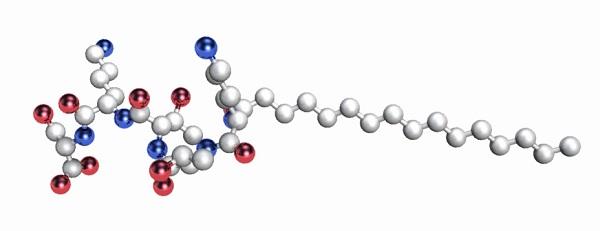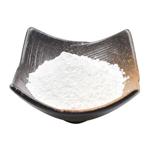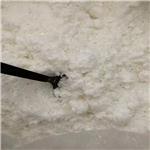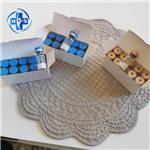Anti-aging Properties of Ghk-Cu
Mar 9,2022
GHK-Cu, or copper tripeptide complex, is a carrier signal peptide discovered in the 1970s for its role in copper transport and hepatocyte survival. Since then, it has been noted as a growth factor for various differentiated cells, a chemotactic agent for macrophages, and a stimulator of nervous tissue regeneration and skin remodeling. GHK-Cu and related oligopeptides, GHK-Mn (manganese tripeptide complex), and Pal-GHK (biopeptide-CL), are less irritating to skin than retinol and tretinoin, making GHK derivatives a desirable option for reducing fine wrinkles in skin.
Mechanism of Action
In anti-aging treatment, GHK-Cu’s role is to stimulate synthesis of EMPs by selectively increasing the expression of metalloproteinase-2 (MMP-2). Also called gelatinase A, this enzyme plays a role in angiogenesis and the breakdown of extra-large collagen IV aggregates in scars, while promoting collagen I formation. MMP-2 also fosters an anti-inflammatory milieu and is known to regulate collagen synthesis in tissue remodeling and embryonic development. As a modulator of MMP-2, GHK-Cu has been termed a matrixin that affects glycosaminoglycan (GAG) synthesis. Treatment with GHK-Cu on rat wounds resulted in increased decorin deposition at the wound site. Since decorin is a GAG involved with collagen fibril organization, this study shows how GHK-Cu stimulation of collagen formation can benefit aging skin.39 GHK-Cu also increases fibroblast proliferation and angiogenesis. The upregulation of vascular endothelial growth factor and fibroblastic growth factor in skin treated with GHK-Cu has been observed. In a recent study, GHK-Cu also decreased secretion of the proinflammatory cytokine interleukin- 6 (IL-6) from dermal fibroblasts in vitro. It has been proposed as a topical anti-inflammatory therapy alternative to corticosteroids, GHK-Cu. One study on dorsally irradiated Sprague Dawley rats which were subsequently treated with GHK-Cu at the wound site found no differences in angiogenesis and blood flow to the wound site compared to control groups. Despite some mixed results on the vascular effects of GHK-Cu, GHK-Cu’s anti-aging and wound healing abilities have been well established molecularly, especially as a modulator in the formation of collagen I and other EMPs including GAGs, PGs, and elastin.
Skin permeability of GHK-Cu
GHK-Cu skin permeability has been investigated extensively. One study used an SC lipophilic model membrane on a Flynn diffusion cell to show that the Kp of GHK-Cu at physiological pH is 3.34 × 10−6, higher than it is in an acidic pH: 0.63 × 10−6, and much higher than Cu(2+) alone: 0.27 × 10−6. The lipophilic layer on this membrane was composed mainly of cerasomes, found naturally in the SC. Using mass spectroscopy, this study also concluded that the GHK-Cu degradation mechanism lies in the histidine- lysine peptide bond.45 A later study by the same investigators used a Franz diffusion cell liposomal membrane to show that GHK-Cu permeability is 1.35 × 10−9, similar to that of GHK alone at 1.36 × 10−9. The Franz model utilizes liquid crystalline systems to imitate the intercellular lipids of the SC. The main difference between the two studies is that the Flynn model investigated GHK-Cu permeation through an aqueous solution, while the Franz model elucidated the copper peptide complex’s permeation ability through an emulsion. This is important since most cosmeceuticals are provided in emulsion form.
Originally, it was believed that GHK was only a carrier peptide for copper, since it significantly improves copper’s penetrative ability through skin. Copper is well known for its role in enzymatic reactions involved with skin repair and collagen production. For example, GHK transdermal delivery of copper can contribute to the copper-dependent enzyme lysyl oxidase, which mediates crosslinking of tropoelasin in the ECM. However, a recent study indicated that Cu-free GHK also had a beneficial effect. Cu-free GHK promoted the stem-ness and proliferative ability of basal epithelial cells, and increased the expression of integrin by keratinocytes. Another study reported that while copper and manganese ions increase the activity of antioxidant enzymes, GHK itself is responsible for increased fibroblast proliferation. Therefore, GHK-Cu and GHK-Mn are termed as both signal and carrier peptides. Furthermore, GHK may be covalently bonded to palmitoyl derivatives to increase their transdermal delivery potential without compromising beneficial anti-aging effects to the skin. Pal-GHK, or Biopeptide CL, is GHK conjugated to palmitic acid. Recently, a mass spectroscopy based assay was developed to detect the presence of pamitoylated oligopeptides in anti-wrinkle creams.
Anti-aging effects of GHK-Cu
Efficacy data displays GHK-Cu’s significant anti-aging effects when used topically. In one nonrandomized control trial, ten volunteers applied topical GHK-Cu and vitamin C on each of their inner thighs. Ten other volunteers applied tretinoin and melatonin. Topical GHK-Cu increased procollagen synthesis in seven of ten volunteers, compared to increased procollagen in four of ten volunteers treated with tretinoin, and five of ten volunteers treated with vitamin C or melatonin. Due to the study design, however, vitamin C and tretinoin were not compared to GHK-Cu on the same subjects. A controlled ex vivo study showed that biotinyl-GHK simulated keratinocyte migration and the remodeling and formation of collagen and laminin. Additionally, two GHK-Cu containing cosmetics, a foundation and a concealer, were evaluated over an eight-week period to facial skin. Both cosmetics showed significant improvements in the skin’s viscoelasticity, with visual changes in appearance in as early as two weeks. A 12-week placebo-controlled GHK-Cu study on 71 women with mild photodamage showed structural changes to facial skin in as soon as one week, with increased skin laxity and clarity. At week 4, there was a significant improvement of wrinkles over placebo. Ultrasound showed an increase in facial skin density and thickness as well. No irritation or adverse consequences were reported. A randomized doubleblinded placebo-controlled study with 67 volunteers also showed the anti-aging effects of GHK-Cu on facial skin, reducing hyperpigmentation in addition to course and fine wrinkles. Dermal keratinocyte proliferation was also induced for all five participants who applied the copper peptide cream to their forearms.
GHK-Cu’s efficacy on periorbital skin has also been investigated in a study including 41 females with photodamage. Compared to vitamin K cream, cream with GHK-Cu significantly improved fine lines, wrinkles, skin thickness, density, viscoelasticity, and the overall appearance of the eyelids. Properties of GHK-Mn have also been investigated. Like copper, a manganese complex can be used by superoxide dismutase to prevent oxidative damage to the body. This is one of the mechanisms by which manganese oligopeptides can prevent UV induced photoaging of skin through the creation of ROS, in addition to stimulating fibroblast growth and EMP production to diminish sallowness and improving skin texture.
- Related articles
- Related Qustion
Aging is caused by many different factors such as the loss of deep bone structure and subcutaneous fat, in addition to oxidative skin damage caused by cumulative sun exposure.....
Mar 9,2022Vitamins and Minerals medicinesKTTKS is a peptide fragment of the carboxy terminal of the propeptide for type I collagen, residues 212– 216. Discovered in 1993, KTTKS was regarded as the minimum sequence necessary to stimulate the production of collagens I and III.....
Mar 9,2022Biochemical EngineeringYou may like









